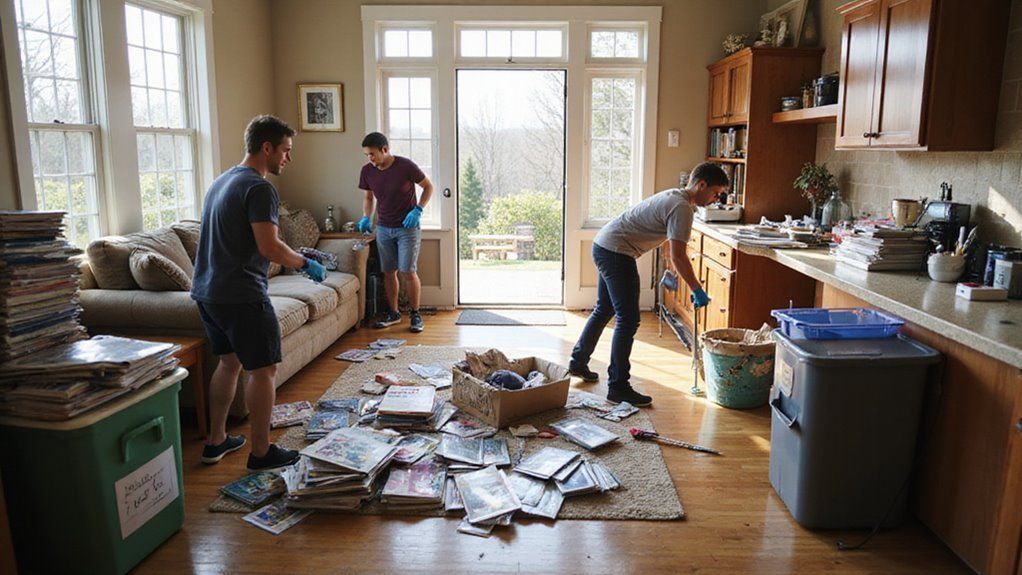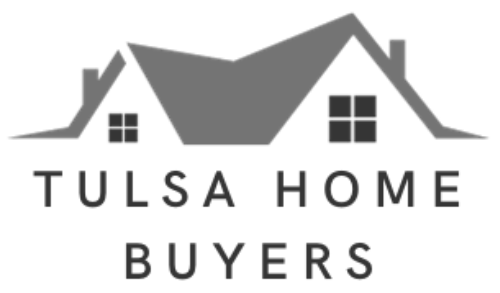How to Clean a Hoarder House Before Selling

Selling a hoarder house is never easy. Hidden clutter, damage, and health hazards can scare buyers away. Many sellers do not realize how much work is needed before listing the house.
The mess can feel overwhelming. Piles of items can hide pests, mold, or structural problems. Failing to clean the house well enough can lower its value or even break local laws.
The best way to clean a hoarder house before selling is to follow a careful, step-by-step plan. This includes removing all clutter, finding hidden hazards, and deep cleaning every room.
This blog will guide you through each step to make the house safe, clean, and ready to sell.
Key Takeaways
- Assess each room for salvageable items, hazards, and damage before starting the cleanup process.
- Gather protective gear, cleaning supplies, and enlist help from trusted individuals or professionals for safety and efficiency.
- Sort belongings by trash, donation, and keep; remove garbage promptly and follow local disposal regulations.
- Deep clean and sanitize all areas, focusing on removing odors, stains, and contaminants for a healthy environment.
- Enhance curb appeal and stage the home by decluttering, organizing, and using neutral décor to attract buyers.
Assessing the Scope of the Cleanup
You must first assess how much cleaning the house needs. Walk through each room and note the amount and types of items. If you see mold, pests, or damage, write that down.
Some items may be worth saving, while others need to be thrown away. This step helps you decide what tools and storage are needed. You might need bins, shelves, or even outside storage.
Hoarding often relates to strong emotions. If a person is struggling, you should offer support or ask a professional for help. A careful assessment helps you avoid surprises and plan a better cleanup.
Before you start cleaning, check who is listed as the owner on the deed, as legal ownership can affect decisions about property management or sale.
Setting Realistic Goals and a Timeline
Start by accurately assessing the project's scope so you know what you're up against. Prioritize key areas that impact safety and daily living, then break the work into actionable milestones.
This lets you set a realistic timeline and measure progress as you go. Remember, if the property has current renters, you'll also need to factor in tenant rights and local laws when setting expectations and scheduling cleanup activities.
Assessing Project Scope
Assessing project scope means understanding the size and details of the cleanup. You need to know what areas need work and how much time it takes. This helps you plan for a smoother process.
Start by walking through every room in the house. Take notes and photos of the messy spots. Identify any dangers, like mold, sharp items, or wobbly piles.
Make a checklist for each area and guess how long each will take to clean. If a room is very full, it may need more time. Set clear goals and break the job into smaller steps.
Consider the people and tools you have. If you need experts, add them to your plan. A clear project scope helps you use your time and money wisely.
Prioritizing Key Areas
Focus first on the most important areas in a hoarder house. Kitchens, bathrooms, and entryways usually need attention before other rooms. These areas affect safety and daily use.
Assess each space and decide what must be done. Set small, clear goals for each room. If needed, ask for help to avoid feeling overwhelmed.
Use simple sorting methods like keep, donate, or throw away. Make a timeline that fits your time and energy. If the task feels too big, take breaks and work in short sessions.
Offer kindness and support to anyone struggling with the process. Remember, steady progress builds confidence. Prioritizing helps you see results and prepares you for deeper cleaning later.
Creating Actionable Milestones
Breaking the job into clear milestones helps you clean a hoarder house efficiently. Each milestone should have a goal and a deadline. This keeps the work organized and less stressful.
Start by checking the entire house and making a list of tasks. Tasks can include removing trash, sorting important items, and planning for pest control. If you split tasks by rooms or areas, it is easier to manage.
You should set a timeline for each task to stay on track. For example, you might clean the kitchen one weekend and schedule pest control the next. If you use a checklist or a simple tracking tool, you can monitor your progress.
Defined objectives and deadlines make the process faster and more thorough. If you follow this plan, the house will be ready to sell sooner. Each step ensures no important detail is missed.
Gathering Essential Cleaning Supplies
Before cleaning a hoarder house, you need the right supplies for safety and efficiency. Heavy-duty gloves, face masks, and protective clothing keep you safe from dust and sharp objects. If you gather these items first, you can avoid health risks.
Strong garbage bags, disinfectants, and multi-surface cleaners help remove mess and germs. Brooms, mops, and scrub brushes are important for deep cleaning. You should use these tools to clean different surfaces.
Strong garbage bags, disinfectants, and scrub brushes are essential for tackling messes and germs on every surface during a hoarder house cleanout.
Clear bins, labels, and shelves make sorting belongings easier. Organizing items prevents confusion and speeds up the process. If you use storage solutions, you can quickly separate valuables from trash.
Essential equipment like flashlights and a step ladder help you reach dark or high areas. You should not forget these tools to ensure a thorough clean. Preparing all supplies in advance saves time and keeps the process safe.
If you are preparing a hoarder house for sale, gathering the right cleaning tools is just as important as selling a house as-is for a fast and hassle-free transaction.
Assembling a Support Team
A hoarder house cleanup is easier with a reliable support team. Working alone can be too hard, both physically and emotionally. The right team helps you stay strong and makes the process smoother.
If you have family or friends who are patient and nonjudgmental, invite them to help. They can assist with sorting items and making decisions. Always choose people you trust.
Professional organizers can offer useful systems for decluttering if you need expert help. They guide you through the process with care and experience. Their support can save you time and effort.
Mental health professionals are important if you feel stressed or overwhelmed. They help you handle emotions and stay healthy during cleaning. Ask for their support when needed.
A good support team gives you a strong start and helps you finish the cleanup. If you choose wisely, you will feel less alone and more confident.
Having a team also makes it easier to schedule a flexible closing date if you plan to sell the home for cash after cleaning, since you can efficiently coordinate the process from cleanup to closing.
Prioritizing Safety Precautions
Safety must come first before you start sorting or removing items. Hoarder houses may contain dangers like mold, sharp items, or pests. Always check the area for unstable piles and poor air quality.
Team members should wear gloves, masks, and sturdy shoes at all times. Personal protective equipment protects you from unknown or dangerous substances. If you find any risks, do not ignore them.
Keep pathways clear and make sure exits are easy to reach. Before beginning a cleanup, it’s also smart to review required disclosures if you plan to sell the property in its current condition, as legal compliance can help protect you and future buyers.
Sorting and Decluttering Room by Room
Sorting and decluttering a house works best when done one room at a time. Focusing on a single space keeps the task manageable. Start with the room that has the least clutter.
Sort items into three groups: keep, donate, or throw away. Use sturdy bins or boxes to hold sorted items. Clear labels help you remember where things belong.
Set realistic goals for each cleaning session. If you need support, ask a trusted friend or family member to help. Take breaks if you feel overwhelmed.
If you find sentimental items, consider seeking emotional support. Stay organized by finishing one room before starting another. This approach helps you see progress and stay motivated.
When preparing a hoarder house for sale, remember that highlight unique features can significantly attract buyers once the clutter is removed.
Disposing of Trash and Unwanted Items
To dispose of trash and unwanted items, take them out of each room right after sorting. Quick removal stops clutter from returning. This keeps your progress steady and the space clear.
Bag all garbage, broken things, and items that cannot be used again. If you have a lot of junk, rent a dumpster or book a junk removal service. These options help manage large or heavy loads.
Bag unusable items and consider a dumpster or junk removal service when dealing with large or heavy loads.
Follow local rules for throwing away special items like paint, batteries, or electronics. Hazardous items should be labeled and kept separate. If you do not know what to do, ask a professional for help.
Proper waste removal creates a cleaner and safer space. It also makes the rest of your work easier. Always handle trash quickly to stay organized.
If the homeowner is living with dementia, consult a professional regarding power of attorney to ensure that any decisions made about disposing of property or selling items are legally valid and protect their best interests.
Donating or Selling Usable Goods
Now that you’ve cleared out the obvious trash, focus on identifying items with resale value or those in good enough condition to donate. Sort these goods efficiently, and don’t hesitate to coordinate with local charities for pickup services to streamline the process.
This approach helps you clear space while giving usable items a second life. To boost your home's appeal even further, consider cleaning or staging the remaining areas before showing or selling the property.
Identifying Valuable Items
Before clearing out a hoarder house, you need to find what is valuable and what is not. Valuable items include things with monetary or sentimental worth. Identifying these helps you avoid throwing out important things.
You should check each area, especially storage spaces like the garage. Some valuable items might be hidden or forgotten there. Collectibles, antiques, or useful tools often have value.
If an item is in good or repairable condition, consider keeping it. You can look up items online or ask an appraiser if you are unsure. Items with special memories should also be saved.
Following a clear process makes sure you do not miss anything important. This helps you get the most out of each item. It also reduces waste during the cleanout.
Coordinating Charitable Pickups
Coordinating charitable pickups helps clear out a hoarder house faster. Charities that offer pickups can remove usable items quickly. This ensures unwanted goods are reused and helps you clean the home.
First, find local organizations that accept donations and provide pickup services. If you schedule pickups, clutter will leave the house sooner. Always check with each group to learn their donation rules.
If you use charitable pickups, you reduce waste and help your community. Donating also makes the house easier to sell or rent. Consider this option when clearing out any home.
Addressing Structural Damage and Repairs
Addressing structural damage and repairs is important after cleaning up the home. Hoarding can hide problems that lower your home's value. If you ignore these issues, selling your home may become harder.
A foundation check should be your first step. Hire a professional to look for cracks or signs of water damage. Fix problems early to avoid bigger expenses.
A roof inspection is also necessary. Experts can find leaks or missing shingles that you might not see. If you repair the roof now, you can avoid future damage.
Plumbing and electrical systems need checking, too. If there are leaks or faulty wiring, they can be unsafe for new buyers. Address these repairs before you list your home.
In addition, addressing any legal claims for unpaid debts such as property liens is essential, as these can delay or complicate the sales process if left unresolved.
Deep Cleaning Floors, Walls, and Surfaces
Now that repairs are complete, you need to address persistent stains and lingering odors on every surface. Focus on thoroughly cleaning and sanitizing high-touch areas to restore a safe and healthy environment. With the right techniques and products, you'll eliminate contaminants and create a space that's truly clean.
For extra support and peace of mind, some sellers choose to incorporate spiritual protection rituals during the cleaning process, drawing inspiration from traditions like the Saint Joseph Prayer.
Removing Stains and Odors
To remove stains and odors in a hoarder house, use a clear and step-by-step method. This helps make the home clean and fresh. Focus on both visible stains and hidden smells.
Start by finding all odor and stain sources in each room. If you see pet stains, use an enzyme cleaner and let it sit before scrubbing. For other stains, pick the right cleaner and follow label directions.
Apply odor-neutralizing sprays to areas with strong smells, especially carpets and walls. These sprays work best when they reach deep into surfaces. If a smell remains, repeat the process.
Steam clean carpets if they are very dirty or smelly. Mop hard floors using a strong disinfectant. If any stains or odors stay, treat them again until they are gone.
A careful cleaning plan will make the house ready for new owners. If you work room by room, you will not miss any spots. Each step brings the home closer to a fresh and healthy state.
Sanitizing High-Touch Areas
Sanitizing high-touch areas is important because these spots collect the most germs. Clean these areas after you remove clutter. This step helps keep everyone healthy.
Start by vacuuming and mopping the floors with a disinfectant. Wipe walls, door handles, light switches, and countertops using EPA-approved cleaners. If you use strong cleaning products, germs are less likely to survive.
Focus on bathrooms and kitchens since they get dirty easily. Steam cleaning works well for deep cleaning, especially on porous surfaces. Always use clean cloths and gloves to stop germs from spreading.
If you clean all high-touch areas carefully, you make the home safer. This also helps the house look better for showings or inspections. Proper cleaning lowers health risks for everyone.
Tackling Odors and Air Quality Issues
Persistent odors and poor air quality are common in hoarder homes, even after cleaning. You must fix these problems to make the home market-ready. Removing the source of the smell is the first step.
Odors often come from pet stains, mold, or rotting items. You should remove these items completely if you want lasting results. Deep cleaning is necessary for true odor removal.
Ventilation is important for fresh air. Open windows and use fans to help air move through the house. Air purifiers and dehumidifiers can also improve air quality.
Enzyme-based cleaners work well on floors, walls, and fabrics. These cleaners break down odor molecules. If the smell remains, repeat the cleaning steps as needed.
A clean, fresh-smelling home is healthier and more attractive to buyers. Good air quality increases your chances of a quick sale. Addressing these issues early saves time later.
Restoring Curb Appeal and Outdoor Spaces
Restoring curb appeal and outdoor spaces is key to transforming a hoarder house. Good outdoor spaces make a home more attractive and welcoming. If you want to sell the property, focus on the yard first.
Remove all trash, broken items, and thick weeds from the yard. Trim bushes, mow the grass, and add easy-care plants for a neat look. If fences or paths are damaged, fix them to improve safety and appearance.
Clean porches, walkways, and driveways until they are tidy and stain-free. Install or repair outdoor lights to make the area safer and highlight nice features. These steps can quickly boost the home's value and make a strong first impression.
Staging the Home for Prospective Buyers
Staging the home helps buyers imagine living there. It is especially important after a hoarding situation. Clean and organized rooms show the home's true potential.
Staging reveals a home's possibilities, making it easier for buyers to picture themselves living there, especially after a hoarding cleanup.
Furniture should be arranged for easy movement. Use simple feng shui ideas to keep walkways open. Remove anything that blocks paths.
Neutral colors on walls and furniture help rooms look bigger. Color coordination creates a calm and unified feeling. Buyers can focus on the space, not the décor.
If possible, let in more natural light. Open all curtains and blinds. Mirrors can also help reflect light and make rooms brighter.
Personal items and clutter should be removed. Minimal decorations keep the home inviting but not busy. Every room should feel simple and welcoming.
Hiring Professional Help if Needed
If the project feels overwhelming, you should consider hiring specialized cleaning services that handle hoarding situations.
You'll need to compare costs and service options to ensure you get the right level of support for your needs. This approach saves you time, reduces stress, and ensures the home meets safety and health standards.
Choosing Specialized Cleaning Services
Special cleaning services are important for hoarder homes with safety or biohazard risks. Standard cleaning is not enough in these cases. Specialized cleaners make sure the home is safe for everyone.
If you hire professionals, check their experience with hoarder houses. Look for companies with proper training in hazardous materials. Certified teams know how to handle dangerous situations.
A good service will inspect the home for hidden dangers before starting work. They should have clear rules for safe disposal and cleaning. If a company follows strict procedures, you can trust the results.
Costs and Service Options
How much you pay for hoarder house cleaning depends on several things. The main factors are the home’s size, how much clutter there is, and if there are dangerous materials. If the job is bigger or harder, the price will be higher.
Most companies give a quote after looking at your home. Prices can be from $1,000 up to $10,000 or more. The cost changes based on your home’s condition and the work needed.
If you compare cleaning services, check their experience and insurance. Some offer full cleaning, junk removal, and small repairs, while others only remove trash. Always ask for a detailed estimate so you know what you are paying for.
Conclusion
If you follow these steps, you can prepare a hoarder house for sale effectively. Each cleaned area and organized space increases the home’s value and appeal. A thorough cleaning makes the selling process smoother.
If you want to avoid the hassle of cleaning and repairs, you can choose to sell your house as-is. We buy houses for cash, no matter the condition. This option saves you time and effort.
If you are ready to start a new chapter, let us help. We at Tulsa Home Buyers can provide a quick, fair cash offer for your property. Contact us today to discuss how we can assist you.
This is paragraph text. Click it or hit the Manage Text button to change the font, color, size, format, and more. To set up site-wide paragrapTulsa Home Buyers • July 19, 2025h and title styles, go to Site Theme.
Ready to work with Tulsa Home Buyers?
Let's connect! We’re here to help.
Send us a message and we’ll be in touch.
Or give us a call today at 111-222-3333


